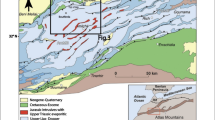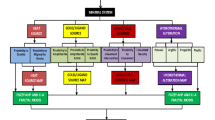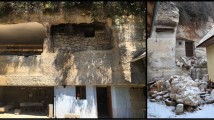Abstract
Since the seminal publication of Henry Darcy’s work in the 1880s, a very large number of rock property values (such as hydraulic conductivity, permeability, compressibility, porosity, etc.) has been measured and published. These data are, however, dispersed and difficult to access. To overcome this problem and to facilitate site characterization (especially stochastic), a worldwide hydrogeological parameter database (wwhypda) is proposed. It is an open and collaborative catalog allowing users to store and retrieve measurements. The catalog is accessible through a web interface (http://wwhypda.org). Presently, it provides individual values and probability density functions of the properties as a function of lithology, scale of observation, location, and geological environment.
Résumé
Depuis la publication des travaux originaux de Henry Darcy (datés 1880) de très nombreuses valeurs de propriétés physiques des roches (conductivité hydraulique, perméabilité, compressibilité, porosité, etc.) ont été obtenues expérimentalement et publiées. Ces données sont toutefois dispersées et donc difficiles d’accès. Pour palier à ce problème et pour ainsi faciliter la caractérisation des aquifères (en particulier par des méthodes stochastiques), cet article propose une base de donnée mondiale de paramètres hydrogéologiques. Il s’agit d’un catalogue librement accessible sur Internet (http://wwhypda.org) pour la consultation et la publication des données. Le catalogue contient actuellement des mesures individuelles et permet de calculer des histogrammes des propriétés en fonction de la lithologie, de l’échelle d’observation, de la localisation et de l’environnement géologique.
Resumen
Desde la publicación originaria del trabajo de Henry Darcy’s en los 1880, una gran cantidad de valores de propiedades de roca (tales como conductividad hidráulica, permeabilidad, compresibilidad, porosidad, etc.) ha sido medidos y publicados. Sin embargo, estos datos están dispersos y son de acceso dificultoso. Para solucionar este problema y facilitar la caracterización de un sitio (especialmente estocástico), se propone una base de datos mundial de parámetros hidrogeológicos (wwhypda). Es un catálogo abierto y colaborativo que permite a los usuarios almacenar y recuperar mediciones. El catálogo está accesible a través de una interfaz web (http://wwhypda.org). Actualmente, provee valores individuales y funciones de densidad de probabilidad de las propiedades en función de la litología, la escala de observación, ubicación y medio geológico.
Riassunto
Fin dalla publicazione dei primi importanti lavori di Henry Darcy (datati 1880) sono stati misurati e pubblicati moltissimi valori delle diverse proprietà delle rocce (ad esempio conducibilità idrauliche, permeabilità, compressibilità, porosità e così via). Tuttavia questi risultati sono dispersi e di non facile accesso. Per sopperire a queste difficoltà e per fornire uno strumento utile nella caratterizzatione di siti, in particolare dal punto di vista stocastico, si propone una banca dati mondiale di parametri idrogeologici (world-wide hydrogeological parameter database: wwhypda). wwhypda é uno strumento di collaborazione che permette agli utilizzatori di contribuire con i propri dati e/o di consultare liberamente la banca dati, il tutto tramite una interfaccia web (http://wwhypda.org). Singole misure e distribuzioni di probabilità sono fornite e catalogate in funzione della litologia, della scala di osservatione, della localizzazione e dell’ambiente geologico relativi.
Resumo
Desde a publicação do trabalho fundador de Darcy nos anos 80 do séc. XIX, têm sido medidos e publicados um número muito grande de valores de propriedades das rochas (como condutividade hidráulica, permeabilidade, compressibilidade, porosidade, etc.). Estes dados, contudo, encontram-se dispersos e difíceis de aceder. Para ultrapassar este problema e facilitar a caracterização de sítios (especialmente estocástica), propõe-se uma base de dados mundial de parâmetros hidrogeológicos (wwhypda: worldwide hydrogeological parameter database). Trata-se de um catálogo colaborativo aberto que permite aos utilizadores introduzir e extrair medições. O catálogo é acessível através de uma interface Internet (http://wwhypda.org). Presentemente fornece valores individuais e funções de densidade de probabilidade de propriedades em função da litologia, da escala de observação, da localização e do enquadramento geológico.





Similar content being viewed by others
References
ADES (2008) ADES groundwater national portal. http://www.ades.eaufrance.fr. Cited October 2008
Alcolea A, Carrera J, Medina A (2006) Pilot points method incorporating prior information for solving the groundwater flow inverse problem. Adv Water Resour 29(1):678–1689
Allen DJ, Brewerton LJ, Coleby LM, Gibbs BR, Lewis MA, Mac Donald AM, Wagstaff SJ, Williams AT (1997) The physical properties of major aquifers in England and Wales. Technical Report WD/97/34, British Geological Survey, Keyworth, UK
Anderson MP, Aiken JS, Webb EK, Mickelson DM (1999) Sedimentology and hydrogeology of two braided stream deposits. Sediment Geol 129(1999):187–199
ASTM (American Society for Testing and Materials) (1985) Classification of soils for engineering purposes: annual book of ASTM standards. 04(08):395–408
Barazzuoli P, Bouzelboudjen M, Cucini S, Kiraly L, Menicori P, Salleolini M (1999) Olocenic alluvial aquifer of the River Cornia coastal plain (southern Tuscany, Italy): database design for groundwater management. Environ Geol 39(2):123–143
BGS (2008) The BGS rock classification scheme. http://www.bgs.ac.uk/bgsrcs/home.html. Cited September 2008
CGDI (2008) The Canadian geospatial data infrastructure. http://www.geoconnections.org. Cited September 2008
Chen PP (1976) The entity-relationship model: toward a unified view of data. ACM Trans Database Syst 1(1):9–36
Chilès JP, Delfiner P (1999) Geostatistics: modeling spatial uncertainty. Wiley, New York
Dagan G (1989) Flow and transport in porous formations. Springer, New-York
Dagan G (2002) An overview of stochastic modeling of groundwater flow and transport: from theory to applications. EOS Trans AGU 83(53):621
Davenport P, Boisvert E, Quat M, Okulitch A, Brodaric B, Colman-Sadd S, Nolan L, Struik B, MacIntyre D, Tzeng P, Scott D, Gilbert C, Abbott G, Bassan A, Journeay M, Francis J, Houlahan T (2002) A scalable, digital map database of bedrock geology for Canada: a progress report. US Geol Surv Open-File Rep 02-370
de Dreuzy JR, Bodin J, Le Grand H, Davy P, Boulanger D, Battais A, Bour B, Gouze P, Porel G (2006) General database for ground water site information. Ground Water 44(5):743–748
de Marsily G, Delay F, Gonçalvès J, Renard P, Teles V, Violette S (2005) Dealing with spatial heterogeneity. Hydrogeol J 13(1):161–183
Deutsch CV, Wang L (1996) Hierarchical object-based stochastic modeling of fluvial reservoirs. Math Geol 28(7):857–880
Diderot D (1755) Encyclopèdie [Encyclopedia]. Extracted from English edition: Diderot D (2001) Rameau’s nephew and other works. (translated by Barzun J, Bowen RH), Hackett, Indianapolis, IN, USA, 283 pp
Freeze RA, Massmann J, Smith L, Sperling T, James B (1990) Hydrogeological decision analysis: 1. a framework. Ground Water 28(5):738–766
Gelhar LW (1993) Stochastic subsurface hydrology. Prentice-Hall, Engelwood Cliffs, NJ
Gelhar LW, Welty C, Rehfeldt KR (1992) A critical review of data on field-scale dispersion in aquifers. Water Resour Res 28(7):1955–1974
Gogu RC, Carabin G, Hallet V, Peters V, Dassargues A (2001) GIS-based hydrogeological databases and groundwater modelling. Hydrogeol J 9:555–569
Jones HK, Morris BL, Cheney CS, Brewerton LJ, Merrin PD, Lewis MA, MacDonald AM, Coleby LM, Talbot JC, McKenzie AA, Bird MJ, Cunningham J, Robinson VK (2000) The physical properties of minor aquifers in England and Wales. British Geological Survey Technical Report WD/00/4. Environment Agency R&D Publ. 68, British Geological Survey, Keyworth, UK, 243 pp
Journel A, Zhang T (2006) The necessity of a multiple-point prior model. Math Geol 38(5):591–610
Keller B, Bläsi HR, Plat NH, Mozley PS, Matter A (1990) Sedimentaere Architektur der distalen Unteren Süsswassermolasse und ihre Beziehung zur Diagenese und den petrophysikalischen. Eigenschaften am Beispiel der Bohrungen Langenthal. [Sedimentary architecture of distal Lower Freshwater Molasse in connection with its diagenesis and petrophysical properties, exemplified by the Lagenthal boreholes]. NAGRA Technical Report 90-41, NAGRA, Baden, Switzerland, 100 pp
Kiraly L (1975) Hydrogeology of karstic terrains, Rapport sur l’état actuel des connaissances dans le domaine des caractères physiques des roches karstiques. [Report on the current state of art of the physical properties of karstic rocks], chapter 5. IAH, Goring, UK
Matheron G (1962) Traité de géostatistique appliquée [Treatise of applied geostatistics]. Technip, Paris
Neuman SP, Di Federico V (2003) Multifaceted nature of hydrogeologic scaling and its interpretation. Rev Geophys 41(3), 1014. doi:10.1029/2003RG000130
Renard P (2007) Stochastic hydrogeology: what professionals really need. Ground Water 45(5):531–541
Rubin Y (2003) Applied stochastic hydrogeology. Oxford University Press, New York
Strebelle S (2002) Conditional simulation of complex geological structures using multiple-point statistics. Math Geol 34(1):1–21
Struik LC, Quat MB, Davenport PH, Okulitch AV et al (2002) A preliminary scheme for multihierarchical rock classification for use with thematic computer-based query systems. Current Research 2002-D10. Geological Survey of Canada, Ottawa
Tarantola A (2005) Inverse problem theory. Society for Industrial and Applied Mathematics, Philadelphia, PA, 342 pp
Taylor BN, Kuyatt E (1994) Guidelines for evaluating and expressing the uncertainty of NIST measurement results. NIST Technical Note 1297. United States Department of Commerce Technology Administration, National Institute of Standards and Technology, Gaithersburg, MD, USA, 20 pp
US Geological Survey (USGS) (2000) Ground water atlas of the Unites States. United States Geological Survey, Reston, VA. http://pubs.usgs.gov/ha/ha730/gwa.html. Cited October 2008
Vanderborght J, Vereecken H (2007) Review of dispersivities for transport modeling in soils. Vadose Zone J 6:29–52
Zhang YK, Zhang D (2004) Forum: the state of stochastic hydrology. Stoch Environ Res Risk Assess (2004)18:265
Acknowledgements
This work is funded by the Swiss National Science Foundation (Grant PP002-106557). The authors are grateful to many colleagues who helped in the design process and provided thoughtful advice: Y. Abe, A. Alcolea, S. Cattin, M. Garlick, C. Laux, R. Mackay, F. Machado Porto, G. de Marsily, A. Rivera, M.T. Schafmeister, C. Simmons, S. Tissot, C. Vangenot, and C. Voss.
Author information
Authors and Affiliations
Corresponding author
Rights and permissions
About this article
Cite this article
Comunian, A., Renard, P. Introducing wwhypda: a world-wide collaborative hydrogeological parameters database. Hydrogeol J 17, 481–489 (2009). https://doi.org/10.1007/s10040-008-0387-x
Received:
Accepted:
Published:
Issue Date:
DOI: https://doi.org/10.1007/s10040-008-0387-x




